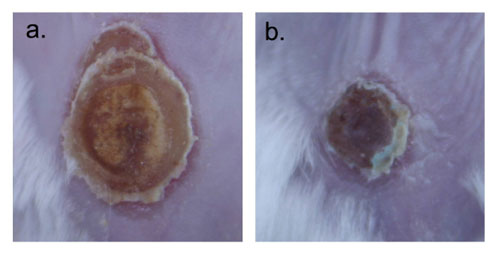| Posted: Jun 21, 2013 | |
Innovative nanoparticle therapy to treat infected burn wounds |
|
| (Nanowerk Spotlight) Despite significant advances in the medical/surgical management of severe thermal injury, wound infection and subsequent sepsis persist as frequent causes of morbidity and mortality for burn victims not only due to the extensive compromise of the protective barrier against microbial invasion, but also as a result of growing pathogen resistance to our therapeutic options. | |
| Burn wounds are further complicated by injury induced suppression of the immune system, further facilitating localized colonization and systemic entry of microbes from both endogenous and exogenous origins. Candida yeast species represent a prevalent threat to these patients, many variants demonstrating resistance to first line systemic antifungal treatments as these medications are not directly toxic, but instead inhibit yeast growth through a single mechanism of action. | |
| Therefore, innovative therapies are urgently needed that overcome mechanisms of pathogen resistance, and are easily administered without concerning systemic side effects. | |
| Nanoparticles represent a practical platform through which both established drugs and novel agents can be encapsulated and delivered more effectively or via new routes to target and reach pathogen cells/machinery with greater success then their macromolecular counterparts. | |
| In a paper published in the June 14, 2013 online edition of Nanomedicine: Nanotechnology, Biology and Medicine ("Amphotericin B releasing nanoparticle topical treatment of Candida spp. in the setting of a burn wound") we demonstrated that encapsulating Amphotericin B, a intravenously administered potent fungicidal polyene macrolide, in nanoparticles increased its killing impact against numerous candida species, was more effective at preventing candidal biofilm formation, and cleared a mouse burn model infected with candida more effectively than solubilized amphotericin. | |
 |
|
| Images were taken on day 9 after infection. a) is topically applied solubilized Amphotericin B and b) Amphotericin B nanoparticle applied. (Images: Dr. Friedman, Montefiore - Albert Einstein College of Medicine) | |
| Materials at the nanoscale have a greater likelihood of interacting with their desired target, here, the cell wall, and therefore the payloads have greater efficacy. Furthermore, the nanoparticles themselves can physically damage pathogen structures and prevent cell-to-cell communication and sharing of resources, offering synergists but different antifungal properties. | |
| Encapsulating amphotericin in nanoparticles not only made it more effective, but also allowed for it to be directly and topically applied to a wound – an option not currently available. Systemic delivery, while very effective, comes at a great cost as amphotericin has multiple well established side effects and toxicities associated with its use. | |
| Our team here at Einstein represents a broad range of expertise calling from multiple departments including medicine (infectious diseases, dermatology), physiology and biophysics, and immunology and microbiology, highlighting the multidisciplinary nature of nanotechnology research. Other authors included David Sanchez; David Schairer; Chaim Tuckman-Vernon; Jason Chouake; Allison Kutner; Joy Makdisi; Joel Friedman; and Joshua d Nosanchuk. | |
|
By Dr. Adam Friedman, Assistant Professor of Medicine (Dermatology)/ Physiology and Biophysics, and Director of Dermatologic Research at Montefiore Medical Center - Albert Einstein College of Medicine.
|
|
|
Become a Spotlight guest author! Join our large and growing group of guest contributors. Have you just published a scientific paper or have other exciting developments to share with the nanotechnology community? Here is how to publish on nanowerk.com. |
|
